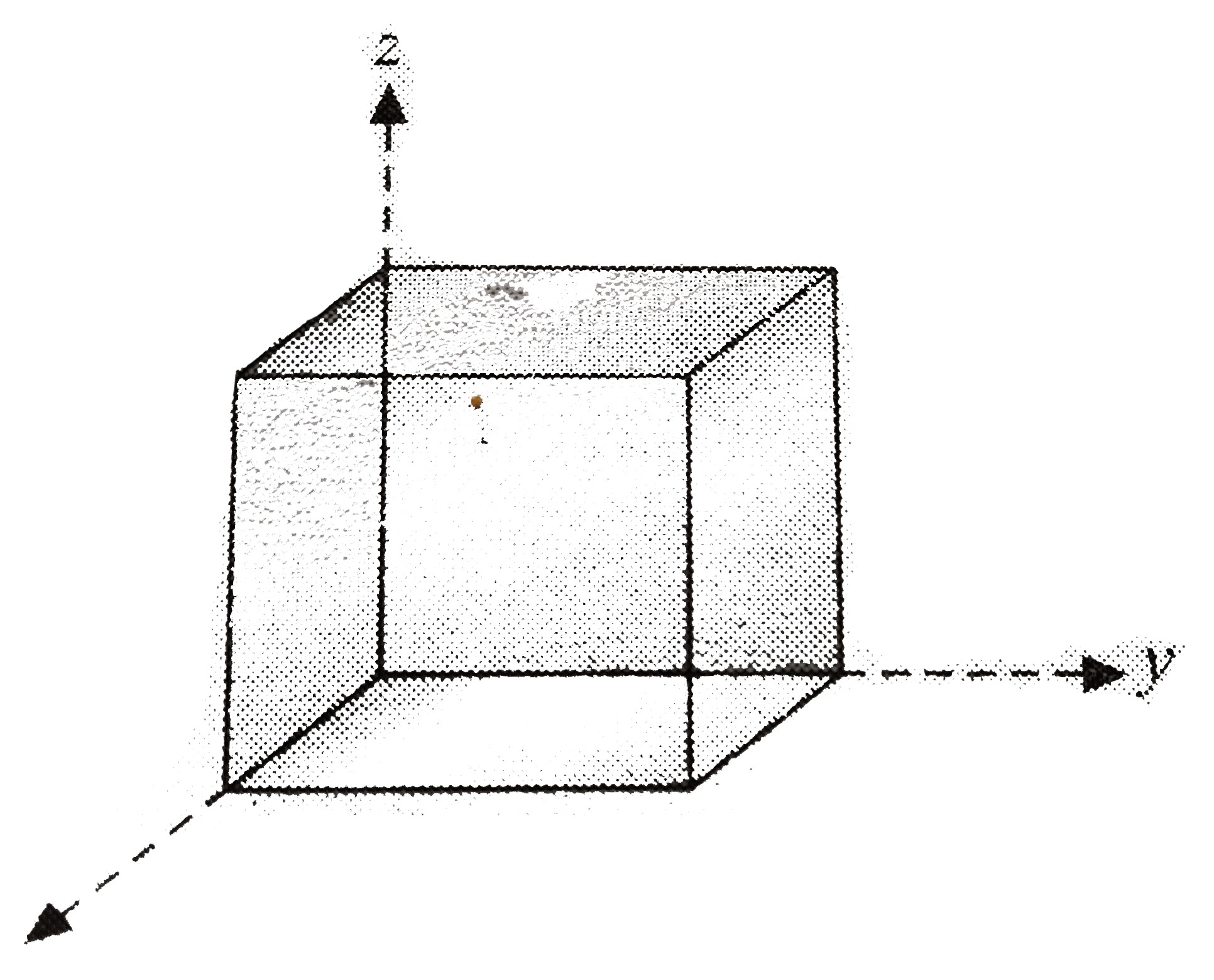In a region of space the electric field in the x-direction and proportional to xi.e., →E=E0xˆi. Consider an imaginary cubical volume of edge a with its parallel to the axes of coordinates. The charge inside this volume will be
Zero
ε0E0a3
1ε0E0a3
16ε0E0a3
The correct Answer is:b
To find the charge enclosed in a cubical volume in a region where the electric field is given by →E=E0x^i, we can use Gauss's law, which states:
ΦE=Qencϵ0
where ΦE is the electric flux through a closed surface, Qenc is the charge enclosed by that surface, and ϵ0 is the permittivity of free space.
1. Identify the Geometry:
We have a cube of edge length a aligned with the coordinate axes. The cube's vertices can be labeled based on their coordinates.
2. Calculate the Electric Flux through Each Face of the Cube:
The electric field varies with x, so we need to calculate the flux through each face of the cube.
- Face A (x = x₀): The outward normal vector is −^i. The electric field at this face is →E=E0x0^i. The area vector dA is A2(−^i), where A=a. Thus, the flux through this face is:
ΦA=→E⋅dA=E0x0A2(−1)=−E0x0a2
- Face B (x = x₀ + a): The outward normal vector is ^i. The electric field at this face is →E=E0(x0+a)^i. The area vector dA is A2^i. Thus, the flux through this face is:
ΦB=→E⋅dA=E0(x0+a)A2=E0(x0+a)a2
- Faces C, D, E, F: The electric field has no component in the ^j and ^k directions, so the flux through these faces is zero:
ΦC=ΦD=ΦE=ΦF=0
3. Total Electric Flux:
The total electric flux through the cube is the sum of the fluxes through all faces:
Φtotal=ΦA+ΦB+ΦC+ΦD+ΦE+ΦF
Substituting the values:
Φtotal=−E0x0a2+E0(x0+a)a2=E0a2(x0+a−x0)=E0a3
4. Apply Gauss's Law:
Using Gauss's law:
ΦE=Qencϵ0
We can equate the total flux to the charge enclosed:
E0a3=Qencϵ0
Rearranging gives:
Qenc=E0a3ϵ0
Final Answer:
The charge enclosed in the cubical volume is:
Qenc=E0a3ϵ0
We have a cube of edge length a aligned with the coordinate axes. The cube's vertices can be labeled based on their coordinates.
The electric field varies with x, so we need to calculate the flux through each face of the cube.
ΦA=→E⋅dA=E0x0A2(−1)=−E0x0a2
ΦB=→E⋅dA=E0(x0+a)A2=E0(x0+a)a2
ΦC=ΦD=ΦE=ΦF=0
The total electric flux through the cube is the sum of the fluxes through all faces:
Φtotal=ΦA+ΦB+ΦC+ΦD+ΦE+ΦF
Substituting the values:
Φtotal=−E0x0a2+E0(x0+a)a2=E0a2(x0+a−x0)=E0a3
Using Gauss's law:
ΦE=Qencϵ0
We can equate the total flux to the charge enclosed:
E0a3=Qencϵ0
Rearranging gives:
Qenc=E0a3ϵ0
The charge enclosed in the cubical volume is:
Qenc=E0a3ϵ0
Topper's Solved these Questions
- ELECTRIC FLUX AND GAUSS LAWBOOK - CENGAGE PHYSICS ENGLISHCHAPTER - ELECTRIC FLUX AND GAUSS LAWEXERCISE - Subjective type
7 Videos
- ELECTRIC CURRENT AND CIRCUITBOOK - CENGAGE PHYSICS ENGLISHCHAPTER - ELECTRIC CURRENT AND CIRCUITEXERCISE - Interger
8 Videos
- ELECTRIC POTENTIALBOOK - CENGAGE PHYSICS ENGLISHCHAPTER - ELECTRIC POTENTIALEXERCISE - DPP 3.5
15 Videos
Similar Questions
In a uniform electric field E if we consider an imaginary cubical closed surface of side a, then find the net flux through the cube ?
View SolutionThe electric field in a region is given by →E=E0xˆi. The charge contained inside a cubical volume bounded by the surface x=0, x=2m, y=0, y=2m, z=0 and z=2m is nε0E0. Find the va,ue of n.
View SolutionThe electric field in a region is given by →E=E0axˆi. Find the electric flux passing through a cubical volume bounded by the surfaces x=0,x=a,y=0,y=a,z=0 and z=a.
View SolutionThe electric field in a cubical volume is
→E=E0(1+za)ˆi+E0(za)ˆj

Each edge of the cube measures d, and one of the corners lies at the origin of the coordinates. Determine the net charge within the cube.
View SolutionThe electric field in a region of space is given by, →E=E0ˆi+2E0ˆj where E0=100N/C. The flux of this field through a circular surface of radius 0.02m parallel to the Y-Z plane is nearly.
View SolutionIn a region of space uniform electric field is present as →E=E0ˆi and uniform magnetci field is present as →B=−B0ˆj . An electron is released from rest at origin. What is the path followed by electron after released. (E0&B0are positive constants )
View SolutionElectric field in a region is given by →E=−4xˆi+6yˆj. Then find the charge enclosed in the cube of side 1m oriented as shown in the diagram

View SolutionThe electric field in a region is given by E=E0xlˆi. Find the charge contained inside a cubical 1 volume bounded by the surfaces x=0,x=a,y=0,yh=,z=0 and z=a. Take E0=5×103N/C l=2cm and a=1m.
View SolutionTwo long parallel conducting horizontal rails are connected by a conducting wire at one end. A uniform magnetic field B (directed vertically downwards) exists in the region of space.

A light uniform ring of diameter d which is practically equal to separation between the rails is placed over the rails as shown in Fig. If resistance of ring be (λ) per unit length
The force required to pull the ring with uniform velocity v is
View SolutionThe magnetic field existing in a region is given by →B=B0(1+xl)→k. A square loop of edge l and carrying a current I, is placed with its edges parallel to the x-y axes. Find the magnitude of the net magnetic force experienced by the loop.
View Solution
